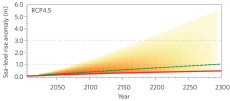Rising Sea Levels Due to Global Warming Are Unstoppable
Mitigation can slow down but not prevent sea level rise for centuries to come
August 5, 2013
Contact: Linda Vu, Lvu@lbl.gov, +1 510 495 2402

Because seawater absorbs heat more slowly than the atmosphere above it, our oceans won't feel the full impact of the greenhouse gases already in the air for hundreds of years. Warm water expands, raising sea levels. (Courtesy W. Washington) Select to enlarge.
A reduction in greenhouse gas emissions could greatly lessen the impacts of climate change. However, the gases already added to the atmosphere ensure a certain amount of sea level rise to come, even if future emissions are reduced. A study by National Center for Atmospheric Research (NCAR) scientist Gerald Meehl and colleagues quantifies the impact on oceans of the “climate commitment” being made now by human activity.
As the atmosphere heats up, the world’s oceans absorb heat more slowly, due to the physical properties of sea water, the oceans' vast depth, and other characteristics. So there is lag time as the heat makes its way deeper and deeper into the oceans. This ever increasing volume of warm water slowly expands—a process that occurs over centuries.
Thermal expansion accounts for about 0.8 millimeters per year of sea level rise since the 1970s, almost half of the estimated total sea level rise per year of 1.8 millimeters (0.075 inch). The other contributions come from melting glaciers and ice sheets, as well as other sources such as piping groundwater to the surface. If the most stringent measures to slow warming were put in place now, thermal expansion alone would still cause substantial sea level rise well into the future, the study finds.
Meehl’s team analyzed future warming and potential sea level rise under four mitigation scenarios developed for the next report of the Intergovernmental Panel on Climate Change. In the most aggressive scenario, the world’s energy needs are met largely through renewable energy, nuclear power, and carbon sequestration—a combination that is technologically feasible, though difficult to enact. Under this scenario, there could be “negative emissions” of carbon dioxide by 2070, meaning that more CO2 would be taken out of the atmosphere than emitted.
Even under such aggressive measures, which could result in global cooling by 2100, sea level still continues to rise for centuries. In this scenario, thermal expansion alone would push sea level beyond its 1986–2005 average by 14.2 centimeters (5.5 inches) in the year 2100 and by 24.2 centimeters (9.4 inches) in 2300. These values do not take into account additional sea level rise from melting of glaciers and ice sheets. In comparison, the scenario with least mitigation produces sea level rise of 32.3 cm (12.6 in) by 2100 to 139.4 cm (54.4 in) by 2300 from thermal expansion alone.
The wild card for future sea level rise is uncertainty about the contributions from the Greenland and Antarctic ice sheets, says Meehl. How fast the ice sheets could disintegrate has proven difficult to model, making it challenging for researchers to precisely estimate the total rise in sea level.
According to Meehl, the findings should not dampen efforts to rein in greenhouse gases but should revitalize those efforts. Under the most aggressive scenario, he points out, “Even though we’re already committed to a certain amount of sea level rise, it’s not going to go up nearly as much as if we don’t do anything.”
Publication: G. A. Meehl, A. Hu, C. Tebaldi, J. M. Arblaster, W. M. Washington, H. Teng, B. Sanderson, T. Ault, W. G. Strand, and J. B. White III, “Relative Outcomes of Climate Change Mitigation Related to Global Temperature versus Sea Level Rise,” Nature Climate Change 2, 576–580 (2012), doi:10.1038/nclimate1529.
About NERSC and Berkeley Lab
The National Energy Research Scientific Computing Center (NERSC) is a U.S. Department of Energy Office of Science User Facility that serves as the primary high performance computing center for scientific research sponsored by the Office of Science. Located at Lawrence Berkeley National Laboratory, NERSC serves almost 10,000 scientists at national laboratories and universities researching a wide range of problems in climate, fusion energy, materials science, physics, chemistry, computational biology, and other disciplines. Berkeley Lab is a DOE national laboratory located in Berkeley, California. It conducts unclassified scientific research and is managed by the University of California for the U.S. Department of Energy. »Learn more about computing sciences at Berkeley Lab.







